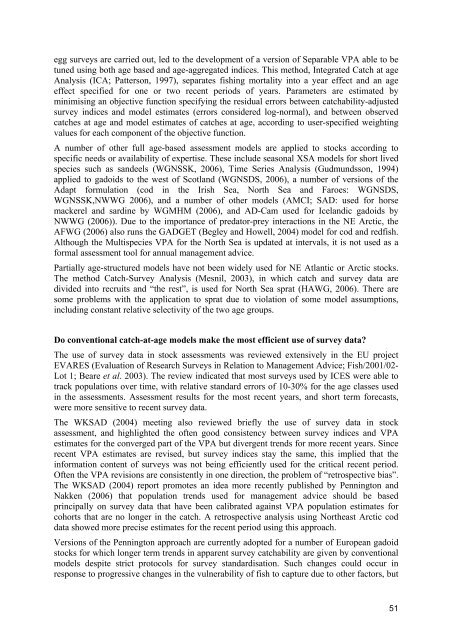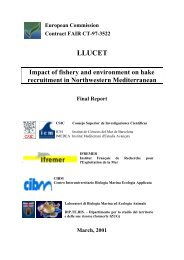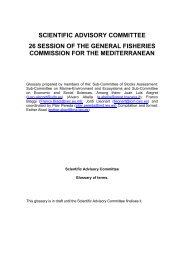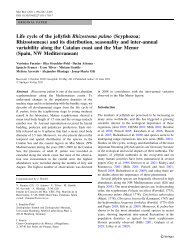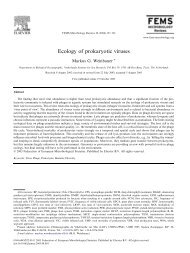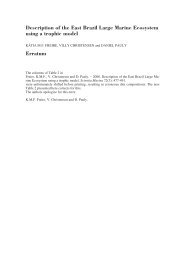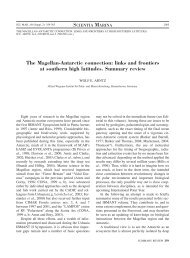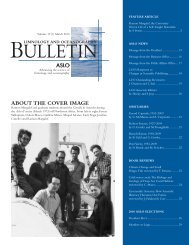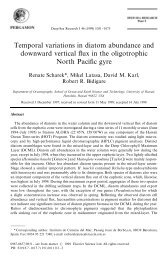REPORT OF THE WORKSHOP ON TRAWL SURVEY ... - FAO.org
REPORT OF THE WORKSHOP ON TRAWL SURVEY ... - FAO.org
REPORT OF THE WORKSHOP ON TRAWL SURVEY ... - FAO.org
You also want an ePaper? Increase the reach of your titles
YUMPU automatically turns print PDFs into web optimized ePapers that Google loves.
egg surveys are carried out, led to the development of a version of Separable VPA able to be<br />
tuned using both age based and age-aggregated indices. This method, Integrated Catch at age<br />
Analysis (ICA; Patterson, 1997), separates fishing mortality into a year effect and an age<br />
effect specified for one or two recent periods of years. Parameters are estimated by<br />
minimising an objective function specifying the residual errors between catchability-adjusted<br />
survey indices and model estimates (errors considered log-normal), and between observed<br />
catches at age and model estimates of catches at age, according to user-specified weighting<br />
values for each component of the objective function.<br />
A number of other full age-based assessment models are applied to stocks according to<br />
specific needs or availability of expertise. These include seasonal XSA models for short lived<br />
species such as sandeels (WGNSSK, 2006), Time Series Analysis (Gudmundsson, 1994)<br />
applied to gadoids to the west of Scotland (WGNSDS, 2006), a number of versions of the<br />
Adapt formulation (cod in the Irish Sea, North Sea and Faroes: WGNSDS,<br />
WGNSSK,NWWG 2006), and a number of other models (AMCI; SAD: used for horse<br />
mackerel and sardine by WGMHM (2006), and AD-Cam used for Icelandic gadoids by<br />
NWWG (2006)). Due to the importance of predator-prey interactions in the NE Arctic, the<br />
AFWG (2006) also runs the GADGET (Begley and Howell, 2004) model for cod and redfish.<br />
Although the Multispecies VPA for the North Sea is updated at intervals, it is not used as a<br />
formal assessment tool for annual management advice.<br />
Partially age-structured models have not been widely used for NE Atlantic or Arctic stocks.<br />
The method Catch-Survey Analysis (Mesnil, 2003), in which catch and survey data are<br />
divided into recruits and “the rest”, is used for North Sea sprat (HAWG, 2006). There are<br />
some problems with the application to sprat due to violation of some model assumptions,<br />
including constant relative selectivity of the two age groups.<br />
Do conventional catch-at-age models make the most efficient use of survey data?<br />
The use of survey data in stock assessments was reviewed extensively in the EU project<br />
EVARES (Evaluation of Research Surveys in Relation to Management Advice; Fish/2001/02-<br />
Lot 1; Beare et al. 2003). The review indicated that most surveys used by ICES were able to<br />
track populations over time, with relative standard errors of 10-30% for the age classes used<br />
in the assessments. Assessment results for the most recent years, and short term forecasts,<br />
were more sensitive to recent survey data.<br />
The WKSAD (2004) meeting also reviewed briefly the use of survey data in stock<br />
assessment, and highlighted the often good consistency between survey indices and VPA<br />
estimates for the converged part of the VPA but divergent trends for more recent years. Since<br />
recent VPA estimates are revised, but survey indices stay the same, this implied that the<br />
information content of surveys was not being efficiently used for the critical recent period.<br />
Often the VPA revisions are consistently in one direction, the problem of “retrospective bias”.<br />
The WKSAD (2004) report promotes an idea more recently published by Pennington and<br />
Nakken (2006) that population trends used for management advice should be based<br />
principally on survey data that have been calibrated against VPA population estimates for<br />
cohorts that are no longer in the catch. A retrospective analysis using Northeast Arctic cod<br />
data showed more precise estimates for the recent period using this approach.<br />
Versions of the Pennington approach are currently adopted for a number of European gadoid<br />
stocks for which longer term trends in apparent survey catchability are given by conventional<br />
models despite strict protocols for survey standardisation. Such changes could occur in<br />
response to progressive changes in the vulnerability of fish to capture due to other factors, but<br />
51


